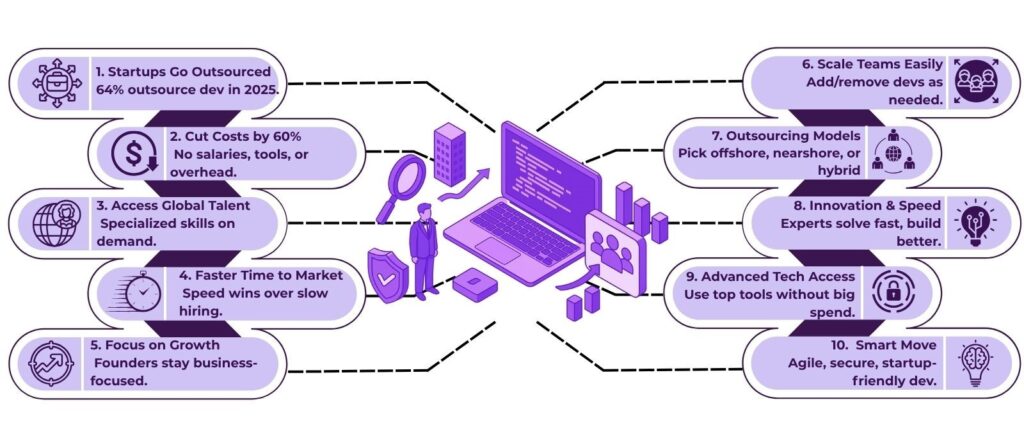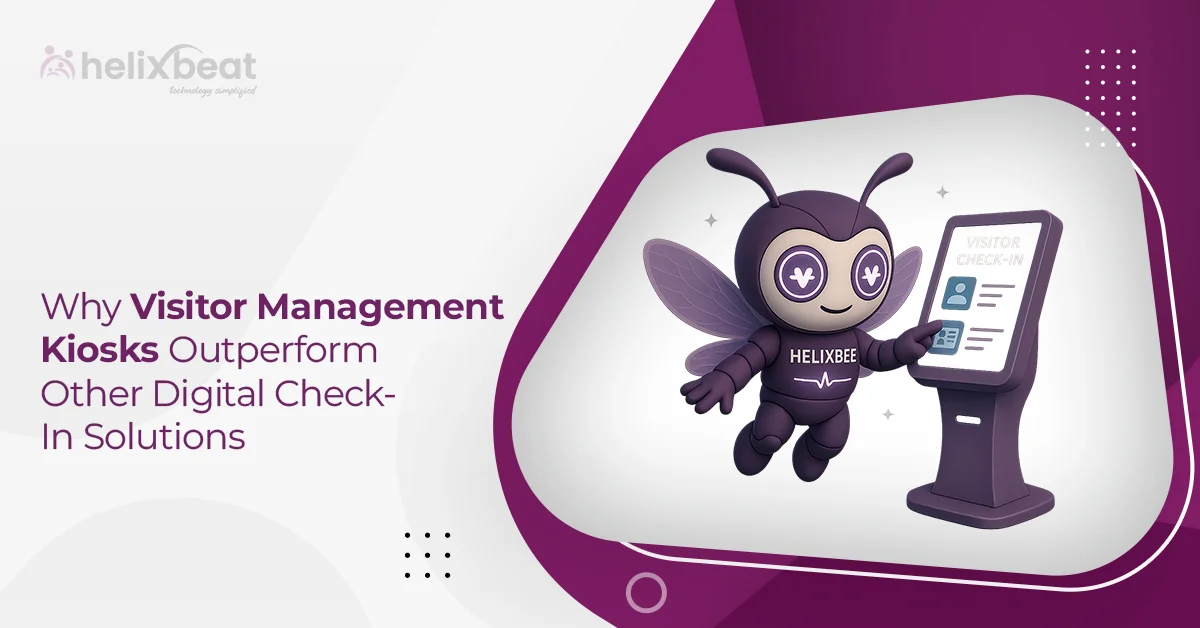Nowadays, for many startups, building an in-house development team is a big challenge. Hiring the right people, paying salaries, and providing training is expensive and complicated. This often makes it hard for startups to grow and keep costs under control. However, by 2025, 64% of startups will address this issue by opting for outsourced product development.
Outsourcing enables them to access skilled talent, reduce costs, and grow more quickly without managing an in-house team.
In this blog, you’ll understand the challenges faced by startups and how outsourcing can be an effective solution.

Table of Contents
What Makes Startups to Outsource Product Development
Startups often face tight budgets, limited resources, and the need for quick growth. These challenges make it difficult for them to maintain a full in-house development team. Outsourcing software development offers several advantages that help startups overcome these issues.
- To Save Money: Outsourcing can save startups up to 60% in development costs compared to in-house teams. A Deloitte report found that 59% of companies outsource to reduce operational costs, allowing startups to save on salaries, office space, and training.
- Access to Skilled Talent: Many startups need specialized skills that may not be available locally. Outsourcing opens the door to a global pool of skilled developers, allowing startups to find the expertise they need for their projects. A Harvard Business Review study revealed that 72% of startups reported better access to high-quality talent through outsourcing.
- Faster Time to Market: Outsourcing can speed up the development process. External teams are often experienced and can hit the ground running, helping startups launch their products faster and stay ahead of competitors. A survey by Statista found that 55% of businesses outsourcing software development experienced faster product launches.
- Focus on Core Business: By outsourcing development tasks, startups can focus on their core business functions, such as marketing, sales, and customer support. This allows them to allocate resources to areas that drive growth rather than managing a development team.
- Scalability and Flexibility: A study from Clutch showed that 57% of businesses outsourced to gain scalability and flexibility. Startups can easily adjust the size of their development team based on project needs without the long-term commitment of hiring full-time employees, which is especially important when scaling quickly.
By outsourcing software development, startups can solve resource gaps, access specialized skills, and increase their growth while minimizing risks and costs.
In-house vs. Outsourced Product development for startups:
Comparison Table:
| Factor | In-House Development | Outsourcing Development |
| Cost | Higher due to salaries, benefits, and infrastructure. | More cost-effective; access to global talent with lower operational costs. |
| Talent Access | Limited to local talent, often requiring lengthy recruitment. | Access to a global pool of skilled professionals with specialized expertise. |
| Speed | Slower to scale; takes time to recruit and onboard. | Faster time to market due to quick scaling and experienced teams. |
| Flexibility | Less flexibility; hard to adjust team size based on project. | High flexibility to scale up or down based on project needs. |
| Risk | Higher risk due to potential expertise gaps and resource limitations. | Lower risk with experienced outsourcing partners managing the project. |
Challenges faced in In-House Development
In-house software development can be a challenging route for startups, especially given their limited resources and the need for rapid growth. While having an in-house team allows for direct control and communication, it often brings several obstacles that can slow down progress and increase costs. Here are some of the key challenges faced:
- Talent Shortage: Attracting and retaining skilled developers can be difficult, especially when competing with larger companies.
- Slow Scalability: Expanding the team quickly is challenging due to the time needed for hiring and onboarding.
- Resource Allocation: Managing an in-house team diverts focus from core business areas like marketing and strategy.
- Limited Expertise: In-house teams may lack specialized skills for complex projects, leading to gaps in development.
- Huge Investment: Hiring a full-time team involves significant expenses, including salaries, benefits, office space, and training.
These challenges can slow down growth and make it harder for startups to stay competitive.
Different Types of Software Development Outsourcing Models
Choosing the right outsourcing model is essential for effective Product Lifecycle Management (PLM), as it impacts the efficiency and quality of product development.
1. Offshore Outsourcing
Offshore outsourcing involves hiring development teams from distant countries, often with a significant time zone difference. It provides access to a large pool of skilled developers at lower costs but may come with communication and cultural challenges.
2. Nearshore Outsourcing
Nearshore outsourcing refers to partnering with development teams in nearby countries, typically in the same time zone. This model helps reduce communication issues while still benefiting from cost savings compared to in-house teams.
3. Onshore Outsourcing
Onshore outsourcing means working with development teams within the same country. It offers easier communication and fewer cultural barriers but tends to be more expensive compared to offshore or nearshore options.
4. Hybrid Model
The hybrid model combines in-house and outsourced teams. Startups use in-house resources for core tasks while outsourcing specific components of development to external experts, offering a balance of control, flexibility, and cost savings.
5. Freelancers/Contract Developers
This model involves hiring individual developers or contractors for specific projects or tasks. It’s highly flexible and cost-effective for short-term needs, but managing multiple freelancers can be challenging.
The Outcome of Outsourced Product Development
Outsourced product development offers startups a range of valuable outcomes that can drive growth and innovation. Here are five distinct advantages:
- Reduced Risk of Failure: With experienced outsourced teams, startups can avoid common development pitfalls. These teams bring industry best practices, reducing the likelihood of mistakes that could derail the project.
- Improved Innovation: External teams bring fresh perspectives and new ideas that can enhance the creativity and innovation of the product, often leading to better solutions that the in-house team may not have considered.
- Faster Problem Solving: Outsourcing to specialists means quicker resolutions to technical challenges. Expert developers have the skills and experience to tackle problems efficiently, reducing downtime and delays.
- Enhanced Quality Control: Many outsourcing partners have strict quality assurance processes in place, ensuring the final product is of high quality. This focus on quality can improve the overall user experience and brand reputation.
- Access to Advanced Technologies: Outsourcing allows startups to leverage cutting-edge technologies and tools that they may not be able to afford or maintain in-house, helping them stay competitive in the market.
These outcomes highlight how outsourcing product development can provide startups with the resources and expertise they need to build high-quality, innovative products without the high costs and complexities of managing everything in-house.
Factors to Consider Before Choosing an Outsourced Product Development Team
Here are the five most important technical factors to consider when choosing an outsourced product development team:
- Technical Competency and Stack Alignment: Ensure the team has deep expertise in the technologies and tools relevant to your project, such as cloud-native solutions, microservices, or DevOps practices, and can handle the complexity of your tech stack.
- Development Methodology Expertise: Verify the team’s proficiency in agile methodologies like Scrum or Kanban to ensure efficient and iterative development cycles that align with your project goals and deadlines.
- Security and Compliance: The team should be well-versed in security protocols (e.g., OWASP) and data protection regulations (e.g., GDPR, HIPAA) and integrate security throughout the development lifecycle (DevSecOps).
- System Integration and API Design: Ensure the team has strong skills in building and integrating scalable APIs, with experience in microservices architecture and third-party integrations, ensuring seamless data flow and system compatibility.
- Performance Optimization and Cloud Readiness: The team should be adept at optimizing application performance, including load balancing, database query optimization, and cloud scalability using platforms like AWS, Azure, or Google Cloud to ensure high availability and fault tolerance.
These factors are critical in ensuring that your outsourced development partner can deliver a high-quality, scalable, and secure product that meets your startup’s needs.
Why Outsourcing Product Development is the Smart Choice for Startups in 2025
We know that 64% of startups in 2025 are choosing outsourced product development over in-house teams. Because outsourcing provides a number of benefits like lower costs, skilled developers, and faster delivery of products to the market, and picking the right outsourcing model, startups can manage their product development smoothly and grow without the high costs of maintaining an in-house team.
Helixbeat is here to help startups succeed with outsourced product development. With our experience in agile development, cloud solutions, and seamless system integration, we make sure your product is built to the highest standards.
Our team provides quality, security, and performance at every stage. If you’re looking to launch a quality product in the market, Helixbeat is the best choice. Partner with us for expert product development.
FAQ:
1. What are four major types of product development?
- New Product Development: Creating entirely new products.
- Improvement: Enhancing existing products.
- Repositioning: Adapting products for different markets.
- Line Extension: Adding variations to an existing product line.
2. What is API in product development?
API (Application Programming Interface) allows different software systems to communicate, enabling integration and the extension of functionality in product development.
3. What is an outsourcing strategy?
An outsourcing strategy involves delegating tasks or functions to external providers to reduce costs, access expertise, and improve efficiency. Types include offshore, nearshore, and onshore outsourcing.
4. What is product development and sourcing?
Product Development is the process of creating and launching a new product.
Sourcing refers to obtaining the materials or services required for production.
5. What is Product Lifecycle Management?
Product Lifecycle Management (PLM) is the management of a product from conception through design, manufacturing, and eventual retirement, ensuring efficient processes and improved product quality.














